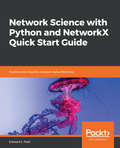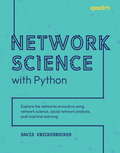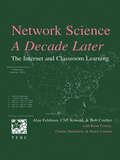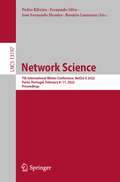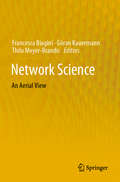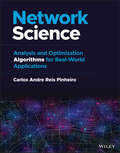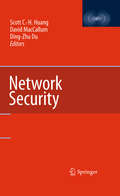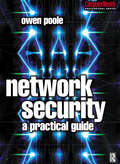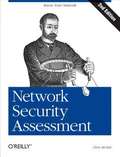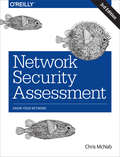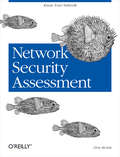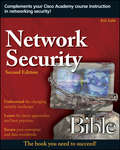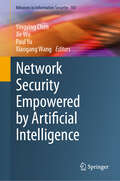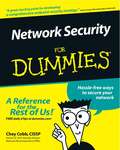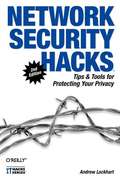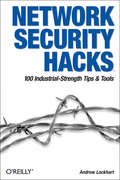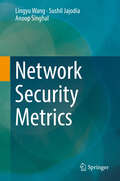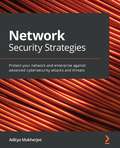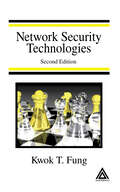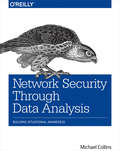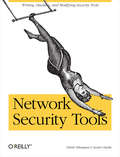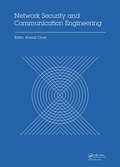- Table View
- List View
Network Science with Python and NetworkX Quick Start Guide: Explore and visualize network data effectively
by Edward L. PlattManipulate and analyze network data with the power of Python and NetworkXKey FeaturesUnderstand the terminology and basic concepts of network scienceLeverage the power of Python and NetworkX to represent data as a networkApply common techniques for working with network data of varying sizesBook DescriptionNetworkX is a leading free and open source package used for network science with the Python programming language. NetworkX can track properties of individuals and relationships, find communities, analyze resilience, detect key network locations, and perform a wide range of important tasks. With the recent release of version 2, NetworkX has been updated to be more powerful and easy to use.If you’re a data scientist, engineer, or computational social scientist, this book will guide you in using the Python programming language to gain insights into real-world networks. Starting with the fundamentals, you’ll be introduced to the core concepts of network science, along with examples that use real-world data and Python code. This book will introduce you to theoretical concepts such as scale-free and small-world networks, centrality measures, and agent-based modeling. You’ll also be able to look for scale-free networks in real data and visualize a network using circular, directed, and shell layouts.By the end of this book, you’ll be able to choose appropriate network representations, use NetworkX to build and characterize networks, and uncover insights while working with real-world systems.What you will learnUse Python and NetworkX to analyze the properties of individuals and relationshipsEncode data in network nodes and edges using NetworkXManipulate, store, and summarize data in network nodes and edgesVisualize a network using circular, directed and shell layoutsFind out how simulating behavior on networks can give insights into real-world problemsUnderstand the ongoing impact of network science on society, and its ethical considerationsWho this book is forIf you are a programmer or data scientist who wants to manipulate and analyze network data in Python, this book is perfect for you. Although prior knowledge of network science is not necessary, some Python programming experience will help you understand the concepts covered in the book easily.
Network Science with Python: Explore the networks around us using network science, social network analysis, and machine learning
by David Knickerbocker Dennis Neer Dr. Ram Singh Shabbir H. Mala Leslie AndrewsDiscover the use of graph networks to develop a new approach to data science using theoretical and practical methods with this expert guide using Python, printed in colorKey FeaturesCreate networks using data points and informationLearn to visualize and analyze networks to better understand communitiesExplore the use of network data in both - supervised and unsupervised machine learning projectsPurchase of the print or Kindle book includes a free PDF eBookBook DescriptionNetwork analysis is often taught with tiny or toy data sets, leaving you with a limited scope of learning and practical usage. Network Science with Python helps you extract relevant data, draw conclusions and build networks using industry-standard – practical data sets. You'll begin by learning the basics of natural language processing, network science, and social network analysis, then move on to programmatically building and analyzing networks. You'll get a hands-on understanding of the data source, data extraction, interaction with it, and drawing insights from it. This is a hands-on book with theory grounding, specific technical, and mathematical details for future reference. As you progress, you'll learn to construct and clean networks, conduct network analysis, egocentric network analysis, community detection, and use network data with machine learning. You'll also explore network analysis concepts, from basics to an advanced level.By the end of the book, you'll be able to identify network data and use it to extract unconventional insights to comprehend the complex world around you.What you will learnExplore NLP, network science, and social network analysisApply the tech stack used for NLP, network science, and analysisExtract insights from NLP and network dataGenerate personalized NLP and network projectsAuthenticate and scrape tweets, connections, the web, and data streamsDiscover the use of network data in machine learning projectsWho this book is forNetwork Science with Python demonstrates how programming and social science can be combined to find new insights. Data scientists, NLP engineers, software engineers, social scientists, and data science students will find this book useful. An intermediate level of Python programming is a prerequisite. Readers from both – social science and programming backgrounds will find a new perspective and add a feather to their hat.
Network Science, A Decade Later: The Internet and Classroom Learning
by Alan Feldman Cliff Konold Bob Coulter Brian ConroyNetwork Science, A Decade Later--the result of NSF-funded research that looked at the experiences of a set of science projects which use the Internet--offers an understanding of how the Internet can be used effectively by science teachers and students to support inquiry-based teaching and learning. The book emphasizes theoretical and critical perspectives and is intended to raise questions about the goals of education and the ways that technology helps reach those goals and ways that it cannot. The theoretical perspective of inquiry-based teaching and learning in which the book is grounded is consistent with the current discipline-based curriculum standards and frameworks. The chapters in Part I, "State of the Art," describe the history and current practice of network science. Those in Part II, "Looking Deeply," extend the inquiry into network science by examining discourse and data in depth, using both empirical data and theoretical perspectives. In Part III, "Looking Forward," the authors step back from the issues of network science to take a broader view, focusing on the question: How should the Internet be used--and not used--to support student learning? The book concludes with a reminder that technology will not replace teachers. Rather, the power of new technologies to give students both an overwhelming access to resources--experts, peers, teachers, texts, images, and data--and the opportunity to pursue questions of their own design, increases the need for highly skilled teachers and forward-looking administrators. This is a book for them, and for all educators, policymakers, students involved in science and technology education. For more information about the authors, an archived discussions space, a few chapters that can be downloaded as PDF files, and ordering information, visit teaparty.terc.edu/book/
Network Science: 7th International Winter Conference, NetSci-X 2022, Porto, Portugal, February 8–11, 2022, Proceedings (Lecture Notes in Computer Science #13197)
by Fernando Silva Pedro Ribeiro José Fernando Mendes Rosário LaureanoThis book constitutes the refereed proceedings of the 7th International Conference and School of Network Science, NetSci-X 2022, held in Porto, Portugal, in February 2021. The 13 full papers were carefully reviewed and selected from 19 submissions. The papers deal with the study of network models in domains ranging from biology and physics to computer science, from financial markets to cultural integration, and from social media to infectious diseases.
Network Science: An Aerial View
by Francesca Biagini Göran Kauermann Thilo Meyer-BrandisThis book provides an overview of network science from the perspective of diverse academic fields, offering insights into the various research areas within network science. The authoritative contributions on statistical network analysis, mathematical network science, genetic networks, Bayesian networks, network visualisation, and systemic risk in networks explore the main questions in the respective fields: What has been achieved to date? What are the research challenges and obstacles? What are the possible interconnections with other fields? And how can cross-fertilization between these fields be promoted? Network science comprises numerous scientific disciplines, including computer science, economics, mathematics, statistics, social sciences, bioinformatics, and medicine, among many others. These diverse research areas require and use different data-analytic and numerical methods as well as different theoretical approaches. Nevertheless, they all examine and describe interdependencies, associations, and relationships of entities in different kinds of networks. The book is intended for researchers as well as interested readers working in network science who want to learn more about the field – beyond their own research or work niche. Presenting network science from different perspectives without going into too much technical detail, it allows readers to gain an overview without having to be a specialist in any or all of these disciplines.
Network Science: Analysis and Optimization Algorithms for Real-World Applications
by Carlos Andre PinheiroNetwork Science Network Science offers comprehensive insight on network analysis and network optimization algorithms, with simple step-by-step guides and examples throughout, and a thorough introduction and history of network science, explaining the key concepts and the type of data needed for network analysis, ensuring a smooth learning experience for readers. It also includes a detailed introduction to multiple network optimization algorithms, including linear assignment, network flow and routing problems. The text is comprised of five chapters, focusing on subgraphs, network analysis, network optimization, and includes a list of case studies, those of which include influence factors in telecommunications, fraud detection in taxpayers, identifying the viral effect in purchasing, finding optimal routes considering public transportation systems, among many others. This insightful book shows how to apply algorithms to solve complex problems in real-life scenarios and shows the math behind these algorithms, enabling readers to learn how to develop them and scrutinize the results. Written by a highly qualified author with significant experience in the field, Network Science also includes information on: Sub-networks, covering connected components, bi-connected components, community detection, k-core decomposition, reach network, projection, nodes similarity and pattern matching Network centrality measures, covering degree, influence, clustering coefficient, closeness, betweenness, eigenvector, PageRank, hub and authority Network optimization, covering clique, cycle, linear assignment, minimum-cost network flow, maximum network flow problem, minimum cut, minimum spanning tree, path, shortest path, transitive closure, traveling salesman problem, vehicle routing problem and topological sort With in-depth and authoritative coverage of the subject and many case studies to convey concepts clearly, Network Science is a helpful training resource for professional and industry workers in, telecommunications, insurance, retail, banking, healthcare, public sector, among others, plus as a supplementary reading for an introductory Network Science course for undergraduate students.
Network Security
by Ding-Zhu Du Scott C.-H. Huang David MaccallumThis book provides a reference tool for the increasing number of scientists whose research is more or less involved in network security. Coverage includes network design and modeling, network management, data management, security and applications.
Network Security
by Owen PooleFirst Published in 2002. Routledge is an imprint of Taylor & Francis, an informa company.
Network Security Assessment, 2nd Edition
by Chris McnabHow secure is your network? The best way to find out is to attack it. Network Security Assessment provides you with the tricks and tools professional security consultants use to identify and assess risks in Internet-based networks-the same penetration testing model they use to secure government, military, and commercial networks. With this book, you can adopt, refine, and reuse this testing model to design and deploy networks that are hardened and immune from attack. Network Security Assessment demonstrates how a determined attacker scours Internet-based networks in search of vulnerable components, from the network to the application level. This new edition is up-to-date on the latest hacking techniques, but rather than focus on individual issues, it looks at the bigger picture by grouping and analyzing threats at a high-level. By grouping threats in this way, you learn to create defensive strategies against entire attack categories, providing protection now and into the future. Network Security Assessment helps you assess: Web services, including Microsoft IIS, Apache, Tomcat, and subsystems such as OpenSSL, Microsoft FrontPage, and Outlook Web Access (OWA) Web application technologies, including ASP, JSP, PHP, middleware, and backend databases such as MySQL, Oracle, and Microsoft SQL Server Microsoft Windows networking components, including RPC, NetBIOS, and CIFS services SMTP, POP3, and IMAP email services IP services that provide secure inbound network access, including IPsec, Microsoft PPTP, and SSL VPNs Unix RPC services on Linux, Solaris, IRIX, and other platforms Various types of application-level vulnerabilities that hacker tools and scripts exploit Assessment is the first step any organization should take to start managing information risks correctly. With techniques to identify and assess risks in line with CESG CHECK and NSA IAM government standards, Network Security Assessment gives you a precise method to do just that.
Network Security Assessment, 2nd Edition
by Chris McnabNetwork Security Assessment provides you with the tricks and tools professional security consultants use to identify and assess risks in Internet-based networks-the same penetration testing model they use to secure government, military, and commercial networks. With this book, you can adopt, refine, and reuse this testing model to design and deploy networks that are hardened and immune from attack.
Network Security Assessment: Know Your Network
by Chris McNabHow secure is your network? The best way to find out is to attack it, using the same tactics attackers employ to identify and exploit weaknesses. With the third edition of this practical book, you’ll learn how to perform network-based penetration testing in a structured manner. Security expert Chris McNab demonstrates common vulnerabilities, and the steps you can take to identify them in your environment.System complexity and attack surfaces continue to grow. This book provides a process to help you mitigate risks posed to your network. Each chapter includes a checklist summarizing attacker techniques, along with effective countermeasures you can use immediately.Learn how to effectively test system components, including:Common services such as SSH, FTP, Kerberos, SNMP, and LDAPMicrosoft services, including NetBIOS, SMB, RPC, and RDPSMTP, POP3, and IMAP email servicesIPsec and PPTP services that provide secure network accessTLS protocols and features providing transport securityWeb server software, including Microsoft IIS, Apache, and NginxFrameworks including Rails, Django, Microsoft ASP.NET, and PHPDatabase servers, storage protocols, and distributed key-value stores
Network Security Assessment: Know Your Network
by Chris McNabThere are hundreds--if not thousands--of techniques used to compromise both Windows and Unix-based systems. Malicious code and new exploit scripts are released on a daily basis, and each evolution becomes more and more sophisticated. Keeping up with the myriad of systems used by hackers in the wild is a formidable task, and scrambling to patch each potential vulnerability or address each new attack one-by-one is a bit like emptying the Atlantic with paper cup.If you're a network administrator, the pressure is on you to defend your systems from attack. But short of devoting your life to becoming a security expert, what can you do to ensure the safety of your mission critical systems? Where do you start?Using the steps laid out by professional security analysts and consultants to identify and assess risks, Network Security Assessment offers an efficient testing model that an administrator can adopt, refine, and reuse to create proactive defensive strategies to protect their systems from the threats that are out there, as well as those still being developed.This thorough and insightful guide covers offensive technologies by grouping and analyzing them at a higher level--from both an offensive and defensive standpoint--helping administrators design and deploy networks that are immune to offensive exploits, tools, and scripts. Network administrators who need to develop and implement a security assessment program will find everything they're looking for--a proven, expert-tested methodology on which to base their own comprehensive program--in this time-saving new book.
Network Security Bible
by Eric ColeThe comprehensive A-to-Z guide on network security, fully revised and updatedNetwork security is constantly evolving, and this comprehensive guide has been thoroughly updated to cover the newest developments. If you are responsible for network security, this is the reference you need at your side.Covering new techniques, technology, and methods for approaching security, it also examines new trends and best practices being used by many organizations. The revised Network Security Bible complements the Cisco Academy course instruction in networking security.Covers all core areas of network security and how they interrelateFully revised to address new techniques, technology, and methods for securing an enterprise worldwideExamines new trends and best practices in use by organizations to secure their enterprisesFeatures additional chapters on areas related to data protection/correlation and forensicsIncludes cutting-edge topics such as integrated cybersecurity and sections on Security Landscape, with chapters on validating security, data protection, forensics, and attacks and threatsIf you need to get up to date or stay current on network security, Network Security Bible, 2nd Edition covers everything you need to know.
Network Security Empowered by Artificial Intelligence (Advances in Information Security #107)
by Yingying Chen Jie Wu Paul Yu Xiaogang WangThis book introduces cutting-edge methods on security in spectrum management, mobile networks and next-generation wireless networks in the era of artificial intelligence (AI) and machine learning (ML). This book includes four parts: (a) Architecture Innovations and Security in 5G Networks, (b) Security in Artificial Intelligence-enabled Intrusion Detection Systems. (c) Attack and Defense in Artificial Intelligence-enabled Wireless Systems, (d) Security in Network-enabled Applications. The first part discusses the architectural innovations and security challenges of 5G networks, highlighting novel network structures and strategies to counter vulnerabilities. The second part provides a comprehensive analysis of intrusion detection systems and the pivotal role of AI and machine learning in defense and vulnerability assessment. The third part focuses on wireless systems, where deep learning is explored to enhance wireless communication security. The final part broadens the scope, examining the applications of these emerging technologies in network-enabled fields.The advancement of AI/ML has led to new opportunities for efficient tactical communication and network systems, but also new vulnerabilities. Along this direction, innovative AI-driven solutions, such as game-theoretic frameworks and zero-trust architectures are developed to strengthen defenses against sophisticated cyber threats. Adversarial training methods are adopted to augment this security further. Simultaneously, deep learning techniques are emerging as effective tools for securing wireless communications and improving intrusion detection systems. Additionally, distributed machine learning, exemplified by federated learning, is revolutionizing security model training. Moreover, the integration of AI into network security, especially in cyber-physical systems, demands careful consideration to ensure it aligns with the dynamics of these systems.This book is valuable for academics, researchers, and students in AI/ML, network security, and related fields. It serves as a resource for those in computer networks, AI, ML, and data science, and can be used as a reference or secondary textbook.
Network Security For Dummies (For Dummies Ser.)
by Chey CobbCNN is reporting that a vicious new virus is wreaking havoc on the world’s computer networks. Somebody’s hacked one of your favorite Web sites and stolen thousands of credit card numbers. The FBI just released a new report on computer crime that’s got you shaking in your boots. The experts will tell you that keeping your network safe from the cyber-wolves howling after your assets is complicated, expensive, and best left to them. But the truth is, anybody with a working knowledge of networks and computers can do just about everything necessary to defend their network against most security threats. Network Security For Dummies arms you with quick, easy, low-cost solutions to all your network security concerns. Whether your network consists of one computer with a high-speed Internet connection or hundreds of workstations distributed across dozens of locations, you’ll find what you need to confidently: Identify your network’s security weaknesses Install an intrusion detection system Use simple, economical techniques to secure your data Defend against viruses Keep hackers at bay Plug security holes in individual applications Build a secure network from scratch Leading national expert Chey Cobb fills you in on the basics of data security, and he explains more complex options you can use to keep your network safe as your grow your business. Among other things, you’ll explore: Developing risk assessments and security plans Choosing controls without breaking the bank Anti-virus software, firewalls, intrusion detection systems and access controls Addressing Unix, Windows and Mac security issues Patching holes in email, databases, Windows Media Player, NetMeeting, AOL Instant Messenger, and other individual applications Securing a wireless network E-Commerce security Incident response and disaster recovery Whether you run a storefront tax preparing business or you’re the network administrator at a multinational accounting giant, your computer assets are your business. Let Network Security For Dummies provide you with proven strategies and techniques for keeping your precious assets safe.
Network Security Hacks
by Andrew LockhartIn the fast-moving world of computers, things are always changing. Since the first edition of this strong-selling book appeared two years ago, network security techniques and tools have evolved rapidly to meet new and more sophisticated threats that pop up with alarming regularity. The second edition offers both new and thoroughly updated hacks for Linux, Windows, OpenBSD, and Mac OS X servers that not only enable readers to secure TCP/IP-based services, but helps them implement a good deal of clever host-based security techniques as well. This second edition of Network Security Hacks offers 125 concise and practical hacks, including more information for Windows administrators, hacks for wireless networking (such as setting up a captive portal and securing against rogue hotspots), and techniques to ensure privacy and anonymity, including ways to evade network traffic analysis, encrypt email and files, and protect against phishing attacks. System administrators looking for reliable answers will also find concise examples of applied encryption, intrusion detection, logging, trending and incident response. In fact, this "roll up your sleeves and get busy" security book features updated tips, tricks and techniques across the board to ensure that it provides the most current information for all of the major server software packages. These hacks are quick, clever, and devilishly effective.
Network Security Hacks: Tips & Tools for Protecting Your Privacy
by Andrew LockhartIn the fast-moving world of computers, things are always changing. Since the first edition of this strong-selling book appeared two years ago, network security techniques and tools have evolved rapidly to meet new and more sophisticated threats that pop up with alarming regularity. The second edition offers both new and thoroughly updated hacks for Linux, Windows, OpenBSD, and Mac OS X servers that not only enable readers to secure TCP/IP-based services, but helps them implement a good deal of clever host-based security techniques as well.This second edition of Network Security Hacks offers 125 concise and practical hacks, including more information for Windows administrators, hacks for wireless networking (such as setting up a captive portal and securing against rogue hotspots), and techniques to ensure privacy and anonymity, including ways to evade network traffic analysis, encrypt email and files, and protect against phishing attacks. System administrators looking for reliable answers will also find concise examples of applied encryption, intrusion detection, logging, trending and incident response. In fact, this "roll up your sleeves and get busy" security book features updated tips, tricks & techniques across the board to ensure that it provides the most current information for all of the major server software packages. These hacks are quick, clever, and devilishly effective.
Network Security Metrics
by Sushil Jajodia Lingyu Wang Anoop SinghalThis book examines different aspects of network security metrics and their application to enterprise networks. One of the most pertinent issues in securing mission-critical computing networks is the lack of effective security metrics which this book discusses in detail. Since "you cannot improve what you cannot measure", a network security metric is essential to evaluating the relative effectiveness of potential network security solutions. The authors start by examining the limitations of existing solutions and standards on security metrics, such as CVSS and attack surface, which typically focus on known vulnerabilities in individual software products or systems. The first few chapters of this book describe different approaches to fusing individual metric values obtained from CVSS scores into an overall measure of network security using attack graphs. Since CVSS scores are only available for previously known vulnerabilities, such approaches do not consider the threat of unknown attacks exploiting the so-called zero day vulnerabilities. Therefore, several chapters of this book are dedicated to develop network security metrics especially designed for dealing with zero day attacks where the challenge is that little or no prior knowledge is available about the exploited vulnerabilities, and thus most existing methodologies for designing security metrics are no longer effective. Finally, the authors examine several issues on the application of network security metrics at the enterprise level. Specifically, a chapter presents a suite of security metrics organized along several dimensions for measuring and visualizing different aspects of the enterprise cyber security risk, and the last chapter presents a novel metric for measuring the operational effectiveness of the cyber security operations center (CSOC). Security researchers who work on network security or security analytics related areas seeking new research topics, as well as security practitioners including network administrators and security architects who are looking for state of the art approaches to hardening their networks, will find this book helpful as a reference. Advanced-level students studying computer science and engineering will find this book useful as a secondary text.
Network Security Strategies: Protect your network and enterprise against advanced cybersecurity attacks and threats
by Aditya MukherjeeBuild a resilient network and prevent advanced cyber attacks and breachesKey FeaturesExplore modern cybersecurity techniques to protect your networks from ever-evolving cyber threatsPrevent cyber attacks by using robust cybersecurity strategiesUnlock the secrets of network securityBook DescriptionWith advanced cyber attacks severely impacting industry giants and the constantly evolving threat landscape, organizations are adopting complex systems to maintain robust and secure environments. Network Security Strategies will help you get well-versed with the tools and techniques required to protect any network environment against modern cyber threats.You'll understand how to identify security vulnerabilities across the network and how to effectively use a variety of network security techniques and platforms. Next, the book will show you how to design a robust network that provides top-notch security to protect against traditional and new evolving attacks. With the help of detailed solutions and explanations, you'll be able to monitor networks skillfully and identify potential risks. Finally, the book will cover topics relating to thought leadership and the management aspects of network security.By the end of this network security book, you'll be well-versed in defending your network from threats and be able to consistently maintain operational efficiency, security, and privacy in your environment.What you will learnUnderstand network security essentials, including concepts, mechanisms, and solutions to implement secure networksGet to grips with setting up and threat monitoring cloud and wireless networksDefend your network against emerging cyber threats in 2020Discover tools, frameworks, and best practices for network penetration testingUnderstand digital forensics to enhance your network security skillsAdopt a proactive approach to stay ahead in network securityWho this book is forThis book is for anyone looking to explore information security, privacy, malware, and cyber threats. Security experts who want to enhance their skill set will also find this book useful. A prior understanding of cyber threats and information security will help you understand the key concepts covered in the book more effectively.
Network Security Technologies
by Kwok T. FungNetwork Security Technologies, Second Edition presents key security technologies from diverse fields, using a hierarchical framework that enables understanding of security components, how they relate to one another, and how they interwork. The author delivers a unique presentation of major legacy, state-of-the-art, and emerging network security tec
Network Security Through Data Analysis
by Michael S CollinsTraditional intrusion detection and logfile analysis are no longer enough to protect today's complex networks. In this practical guide, security researcher Michael Collins shows you several techniques and tools for collecting and analyzing network traffic datasets. You'll understand how your network is used, and what actions are necessary to protect and improve it.Divided into three sections, this book examines the process of collecting and organizing data, various tools for analysis, and several different analytic scenarios and techniques. It's ideal for network administrators and operational security analysts familiar with scripting.Explore network, host, and service sensors for capturing security dataStore data traffic with relational databases, graph databases, Redis, and HadoopUse SiLK, the R language, and other tools for analysis and visualizationDetect unusual phenomena through Exploratory Data Analysis (EDA)Identify significant structures in networks with graph analysisDetermine the traffic that's crossing service ports in a networkExamine traffic volume and behavior to spot DDoS and database raidsGet a step-by-step process for network mapping and inventory
Network Security Through Data Analysis: From Data to Action
by Michael CollinsTraditional intrusion detection and logfile analysis are no longer enough to protect today’s complex networks. In the updated second edition of this practical guide, security researcher Michael Collins shows InfoSec personnel the latest techniques and tools for collecting and analyzing network traffic datasets. You’ll understand how your network is used, and what actions are necessary to harden and defend the systems within it.In three sections, this book examines the process of collecting and organizing data, various tools for analysis, and several different analytic scenarios and techniques. New chapters focus on active monitoring and traffic manipulation, insider threat detection, data mining, regression and machine learning, and other topics.You’ll learn how to:Use sensors to collect network, service, host, and active domain dataWork with the SiLK toolset, Python, and other tools and techniques for manipulating data you collectDetect unusual phenomena through exploratory data analysis (EDA), using visualization and mathematical techniquesAnalyze text data, traffic behavior, and communications mistakesIdentify significant structures in your network with graph analysisExamine insider threat data and acquire threat intelligenceMap your network and identify significant hosts within itWork with operations to develop defenses and analysis techniques
Network Security Tools: Writing, Hacking, and Modifying Security Tools
by Justin Clarke Nitesh DhanjaniIf you're an advanced security professional, then you know that the battle to protect online privacy continues to rage on. Security chat rooms, especially, are resounding with calls for vendors to take more responsibility to release products that are more secure. In fact, with all the information and code that is passed on a daily basis, it's a fight that may never end. Fortunately, there are a number of open source security tools that give you a leg up in the battle.Often a security tool does exactly what you want, right out of the box. More frequently, you need to customize the tool to fit the needs of your network structure. Network Security Tools shows experienced administrators how to modify, customize, and extend popular open source security tools such as Nikto, Ettercap, and Nessus.This concise, high-end guide discusses the common customizations and extensions for these tools, then shows you how to write even more specialized attack and penetration reviews that are suited to your unique network environment. It also explains how tools like port scanners, packet injectors, network sniffers, and web assessment tools function.Some of the topics covered include:Writing your own network sniffers and packet injection toolsWriting plugins for Nessus, Ettercap, and NiktoDeveloping exploits for MetasploitCode analysis for web applicationsWriting kernel modules for security applications, and understanding rootkitsWhile many books on security are either tediously academic or overly sensational, Network Security Tools takes an even-handed and accessible approach that will let you quickly review the problem and implement new, practical solutions--without reinventing the wheel. In an age when security is critical, Network Security Tools is the resource you want at your side when locking down your network.
Network Security and Communication Engineering: Proceedings of the 2014 International Conference on Network Security and Communication Engineering (NSCE 2014), Hong Kong, December 25-26, 2014
by Kennis ChanThe conference on network security and communication engineering is meant to serve as a forum for exchanging new developments and research progresss between scholars, scientists and engineers all over the world and providing a unique opportunity to exchange information, to present the latest results as well as to review the relevant issues on
Network Security with OpenSSL
by Matt Messier John Viega Pravir ChandraOpenSSL is a popular and effective open source version of SSL/TLS, the most widely used protocol for secure network communications. The only guide available on the subject, Network Security with OpenSSLdetails the challenges in securing network communications, and shows you how to use OpenSSL tools to best meet those challenges. Focused on the practical, this book provides only the information that is necessary to use OpenSSL safely and effectively.
